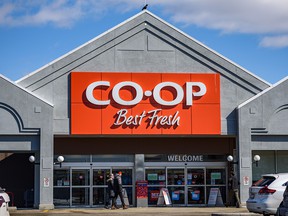
Calgary Co-op emerges from pandemic with growth in mind
As Alberta begins to transition out of the pandemic, Calgary Co-op has seen its growth and projections return to more sustainable levels

Article content
As Alberta begins to transition out of the pandemic, Calgary Co-op has seen its growth and projections return to more sustainable levels.
Advertisement 2
Article content
Overall sales numbers dipped slightly, according to its 2021 annual report released on Thursday, going from $1.26 billion in 2020 to $1.23 last year.
Ken Keelor, Calgary Co-op CEO, said this is a combination of people returning to more normal patterns and softer sales at the pumps due to higher gas prices.
Article content
“We absolutely expected it,” he said in an interview with Postmedia on Friday. “In 2020, there was the pantry loading and in 2021 all grocers and retailers saw a return to more normal volumes.”
Food sales were the biggest drop, going from $737.4 million in 2020 to $674.3 million in 2021, while other entities like liquor, cannabis and home health-care products dropped from $171.8 million to $167.6 million. Gas sales increased from $354.7 million to $387.8 million but had not returned to pre-pandemic levels.
Advertisement 3
Article content
This translated into $21.8 million being sent out to more than 400,000 Co-op members, a drop from $24.5 million in 2020.
He said Calgary Co-op will also be growing its local community contributions to $3 million for this year while expanding on its Food Rescue Project with the Calgary Food Bank.
Change of supplier
Article content
Last year marked two years since the company split with Saskatoon-based Federated Co-operatives Ltd., which is owned by more than 170 retail co-operatives across Western Canada. The split led to litigation, with Calgary Co-op challenging measures taken by FCL following its switch to B.C.-based Save-on-Foods. Co-op still gets its fuel from FCL.
Keelor said the change was critical and has been validated by the development and growth of its own product lines and improved engagement with local producers. In the same process, the company has taken a much more insular approach to its operations, including the production and design of fliers.
Advertisement 4
Article content
“Our business model needed to evolve to match an extremely competitive marketplace and the challenging economy that continues in Calgary and surrounding areas,” he said. “Positioning our food business was not just about buying from a different food distributor, but it was about positioning our business model in food for unique differentiation and allowing us to stick around in a financially sustainable framework for the long term.”

Keelor said this change also helped Co-op deal with the supply chain issues that impacted an entire sector, labour force gaps, pandemic impacts, protesters blocking border crossings, weather disasters and rail strikes.
Focus on building relationships with local producers and a reduction in red tape to getting new products on shelves helped mitigate some of these issues.
Advertisement 5
Article content
“It’s really important with the continuing supply chain issues and the climate change issues, national brands whose prices have been rising, all of those reasons are good reasons to tap into our local suppliers,” he said.
Progress on development projects
Pre-pandemic, Calgary Co-op took an aggressive approach to redevelop some of its key properties.
In March 2019, the company announced four projects at a cost of $2.5 billion with a 10-year timeline. This includes Co-op’s Dalhousie, Oakridge, Brentwood and North Hill properties.
Renovations at the Dalhousie store are complete, including a new car wash in 2021 and gas bar renovations. The food centre has received a complete revamping, including a new deli and sushi area, fresh and vibrant colours, expanded health and beauty while instituting environmental upgrades to LED lighting, high-efficiency coolers and improved H-Vac systems.
Advertisement 6
Article content
Oakridge has just recently entered the second phase of its project after the completion of a two-storey office building. The focus is now on three residential buildings with 270 units and redevelopment of the store, which is targeted for completion in 2026.
Renovations are complete on the Brentwood store while North Hill is being prepared for site development with the demolition of the former Connect First Credit Union building.

Co-op’s flagship downtown store is also undergoing renovations and will have its first Cal and Gary’s Bistro, with a pizza oven and made-to-order lunch and breakfast items.
Calgary Co-op is also proceeding with its Marda Loop project, which will include a new urban store as well as residential retail and commercial spaces after purchasing Marda Loop Village in 2020.
Advertisement 7
Article content
“One of the reasons we’ve been renovating, redeveloping and potentially looking to sites like Marda Loop is to get at customers who have, in some cases, an older shopping experience,” said Keelor, pointing to their old stores at Brentwood and Dalhousie. “Marda Loop is a chance to build a brand new store in a young community, a community of movers and shakers.”
He said it will take five to seven years to complete the project.
This mentality is also being forwarded into the development of the Community Natural Foods properties, after purchasing the brand in 2019. For Keelor, it is important to keep the three-store chain different from regular Co-op stores and to improve on what they currently are doing.
Co-op’s first attempt at this was in the renovation of the 10th Avenue store, which was given an extensive modernization this past year. The company will now turn its focus to replicating some of these changes in the Chinook and Crowfoot locations.
Advertisement 8
Article content
“Our natural food strategy for CNF is all about modernizing the experience without losing the essence of what Community Natural Foods is,” he said.
Pandemic lessons
The pandemic forced Calgary Co-op, like most businesses, to push flexibility to the limits with changes every day. This put a priority on improving communications as it pushed alterations to more than 4,000 employees and 100 stores on a constant stream.
Keelor has also watched as shopping habits shifted from in-store to online and back while the number of people shopping for a household has shifted often to one person. It all makes a difference in what the company does going forward.
Now there is a greater focus on maximizing budgets in the face of 30-year highs in inflation and focus on supporting local producers.
Advertisement 9
Article content
“It’s really coming to life now as people see what’s happening, especially in Alberta versus the rest of Canada, and saying, ‘I’m buying stuff produced here and I’m supporting my economy,’” he said. “I’m hearing from suppliers it’s going to be a year or two years before they get back to what’s normal for them, in terms of the assortment of products.”
Twitter: @JoshAldrich03
More news, fewer ads, faster load time: Get unlimited, ad-lite access to the Calgary Herald, Calgary Sun, National Post and 13 other Canadian news sites for just $14/month or $140/year. Subscribe now through the Calgary Herald or Calgary Sun.





